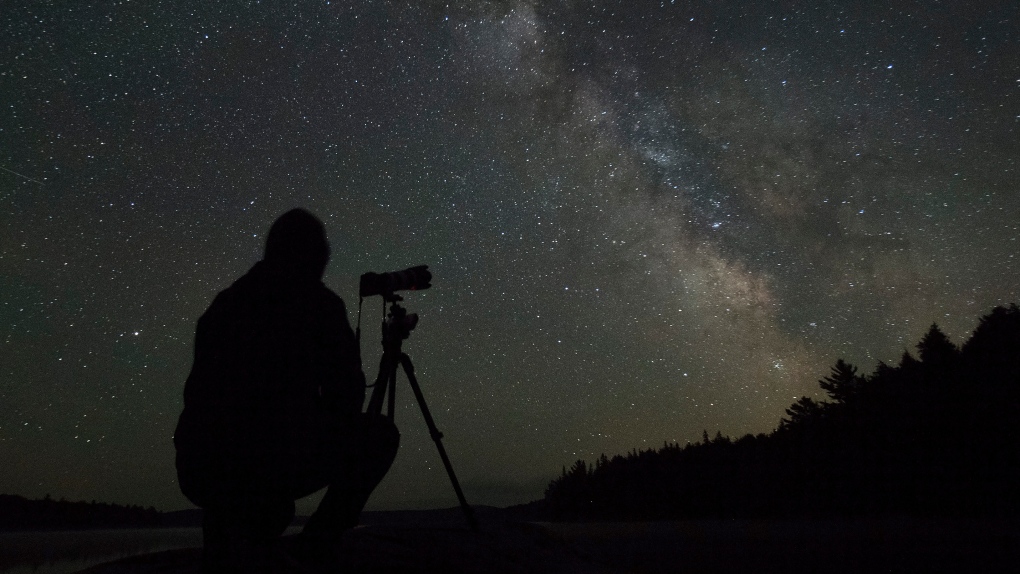5 planets align across the night sky. Here's how to see them in Ontario
 Stargazer Junbo Liang from Toronto photographs the Milky Way lighting up clear night sky over Algonquin Park Saturday June 12, 2021. With provincial re-opening people from across Ontario flocked to Ontario's marquee provincial park. THE CANADIAN PRESS/Fred Thornhill
Stargazer Junbo Liang from Toronto photographs the Milky Way lighting up clear night sky over Algonquin Park Saturday June 12, 2021. With provincial re-opening people from across Ontario flocked to Ontario's marquee provincial park. THE CANADIAN PRESS/Fred Thornhill
Five planets formed a line across the evening sky on Tuesday.
The planetary alignment will include Jupiter, Mercury, Venus, Uranus, and Mars, all visible from Earth, according to sky tracking site Starwalk.
Jupiter and Mercury will appear near the horizon, in the constellation Pisces, while Venus will be visible higher in the sky on the constellation Aries, the sky-tracking site noted.
Next, Uranus will line up nearby but a pair of binoculars may be required to get a glimpse of the planet. Finally, Mars will appear higher in the sky, near the moon, to complete the five-planet alignment.
STARGAZING TIPS
For the best chances to see the planetary alignment clearly in Ontario, astrophotographer Trevor Jones said the first thing you’ll need is clear skies.
In the Toronto area, Tuesday night is forecast to be slightly cloudy, so the planets should be visible. Check the local forecast in your area before heading out to view the alignment.
“Getting away from city light pollution is a big one too,” Jones said in an interview with CTV News Toronto last week. “You'll see much more if you're able to get away from the city lights and get somewhere a little darker.”
Jones also recommends giving your eyes some time to adjust to the darkness.
“If go straight outside, your eyes aren't going to be ready to see anything, so let your eyes adapt to the darkness for 25 minutes or so,” he said.
If possible, travelling to a dark-sky preserve – areas where light pollution has been nearly eliminated and residents can enjoy “celestial landscapes – will give viewers the best shot at a vivid show.
Canada has 13 federally-designated dark-sky preserves, areas where light pollution is kept to a minimum or eliminated completely.
PLACES TO STARGAZE IN ONTARIO
Ontario's federal dark-sky preserves include Point Pelee National Park in Essex County, Fathom Five National Marine Park and Bruce Peninsula National Park near Tobermory, Ont.
Some spots recommended for stargazing, but without official dark-sky designation, include Binbrook Conservation Area in Niagara, Ont., Torrance Barrens in Gravenhurst, Ont., and Lennox and Addington Dark Sky Viewing Area in Napanee, Ont.
Last week, a geomagnetic storm brought a rare appearance of Aurora Borealis to southern Ontario, and residents all over the province were able to take in the spectacle.
With files from CTV News' Adam Frisk.
CTVNews.ca Top Stories

Bird flu, measles top 2025 concerns for Canada's chief public health officer
As we enter 2025, Dr. Theresa Tam has her eye on H5N1 bird flu, an emerging virus that had its first human case in Canada this year.
DEVELOPING Body found in wheel well of plane at Maui airport
A person was found dead in the wheel well of a United Airlines flight to Maui on Tuesday.
Raised in Sask. after his family fled Hungary, this man spent decades spying on communists for the RCMP
As a Communist Party member in Calgary in the early 1940s, Frank Hadesbeck performed clerical work at the party office, printed leaflets and sold books.
Police identify victim of Christmas Day homicide in Hintonburg, charge suspect
The Ottawa Police Service says the victim who has been killed on Christmas Day in Hintonburg has been identified.
Christmas shooting at Phoenix airport leaves 3 people wounded
Police are investigating a Christmas shooting at Sky Harbor Airport in Phoenix that left three people injured by gunfire.
Ship remains stalled on St-Lawrence River north of Montreal
A ship that lost power on the St. Lawrence River on Christmas Eve, remains stationary north of Montreal.
Your kid is spending too much time on their phone. Here's what to do about it
Wondering what your teen is up to when you're not around? They are likely on YouTube, TikTok, Instagram or Snapchat, according to a new report.
Bird flu kills more than half the big cats at a Washington sanctuary
Bird flu has been on the rise in Washington state and one sanctuary was hit hard: 20 big cats – more than half of the facility’s population – died over the course of weeks.
6,000 inmates stage Christmas Day escape from high-security Mozambique prison
At least 6,000 inmates escaped from a high-security prison in Mozambique's capital on Christmas Day after a rebellion, the country's police chief said, as widespread post-election riots and violence continue to engulf the country.































